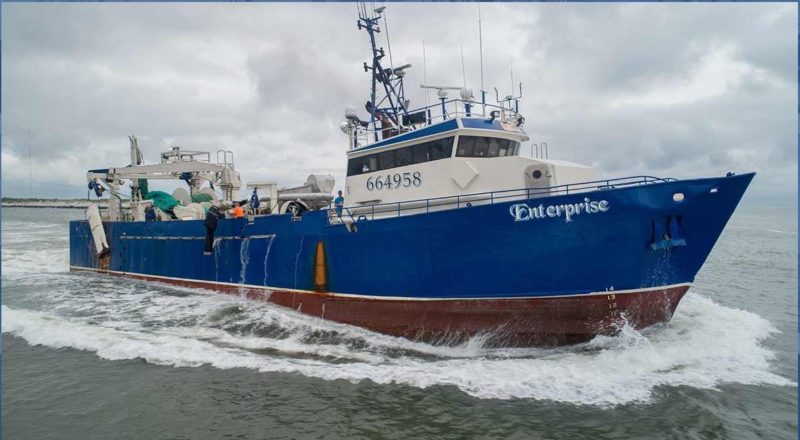New Jersey herring fishermen are going to court challenging a new rule forcing them to pay for at-sea monitoring, which they say will cost more than $700 a day for observers and cut their revenue from herring trips by more than 20 percent.
A half-dozen vessels associated with Lund’s Fisheries, based near Cape May, N.J. are named in the lawsuit filed last week against the New England Fishery Management Council, NOAA and the Department of Commerce.
Cape Trawlers, H&L Axelsson and Loper Bright Enterprises contend regulators have no statutory authority from Congress to impose industry-paid monitoring in addition to a separate, federally-funded observer program.
“The regulation also has the potential to modify other New England fishery management plans to allow for standardized implementation of additional industry-funded monitoring programs in the future,” Lund’s Fisheries said in a joint announcement with the Cause of Action Institute, a Washington, D.C.-based legal and free-market advocacy group.
A final rule published in the Federal Register Feb. 7, to take effect March 9, would require Atlantic herring trawlers with areas A and B permits to pay toward a 50 percent at-sea monitoring coverage target for the first time.
Originating with the 2018 Industry-Funded Omnibus Amendment approved by the New England council, the potential for levying new monitoring requirements had been in the background since being okayed by the Department of Commerce.
“For 2020, we have sufficient federal funding to pay NMFS cost responsibilities associated with fully implementing industry-funded monitoring in the herring fishery,” the agency notice stated. “We estimate industry-funded monitoring cost responsibilities for the herring fishery to total approximately $100,000 in 2020.”
Beginning on April 1, “vessels issued Category A or B herring permits will be required to pay for at-sea monitoring coverage on trips we select for industry-funded monitoring coverage,” according to the notice. “Alternatively, herring vessels will have the option of requesting an EFP (exempted fishery permit) to use electronic monitoring and portside sampling instead of at-sea monitoring coverage to satisfy industry-funded monitoring requirements in 2020.”
But the fishermen say there has not been biological justification for the step, and news from NMFS staff that the requirement would be implemented this spring still came as somewhat of a surprise.
"The federal government finalized this regulation despite having no authority from Congress to do so,” said Ryan Mulvey, a lawyer with the Cause of Action Institute who with co-counsel Eric Bolinder filed the lawsuit in the federal District Court for the District of Columbia. The institute has previously represented New England groundfish captains, and the Drakes Bay Oyster Company of California in its 2013 challenge when the Department of Interior refused to renew its shellfish lease.
“Commercial fishermen and their friends have been raising concerns about the inadequate legal basis for industry-funded at-sea monitoring for years," Mulvey said in a joint statement with Lund’s. “But regulators have ignored these arguments. We cannot let the administrative state push rules that go beyond its power and crush an already-beleaguered industry.”
NMFS implemented cuts in the herring allowable catch limit from 49,900 metric tons in 2018, and again to 15,065 metric tons in 2019 — continuing a downward trend from 2014 when the ACL had been set at 104,088 metric tons.
The A and B permit midwater trawlers saw their herring revenue fall sharply from $13.4 million in 2014 to $7.8 million in 2018, according to NMFS data. Meanwhile the price of herring shot up almost 70 percent in those same years, from $310 per metric ton to $525, according to the agency.
The new monitoring requirement comes at a time when Congressional advocates for Northeast groundfishermen are trying to get at-sea monitoring fully funded by NOAA — and as the New England council considers amending the groundfish management plan to require 100 percent at-sea monitoring, whether through observers or the emerging technology for electronic monitoring.
Both would be expensive for herring fishermen to pay under the new rule, projected at more than $700 a day for observers, and still over $500 to engage third-party electronic monitoring, according to the lawsuit.
"The herring trawl fishery and been vilified and over-regulated, with little demonstrated biological benefit to the herring resource, for too long. If our vessels are forced to pay these at-sea monitoring fees, it may drive some of us out of business, as several boats have already been forced out of the fishery through reduced quotas and burdensome regulation," said Jeff Kaelin, director of sustainability and government relations at Lund's Fisheries.
"The herring trawl fishery is heavily monitored and regulated already — with everything from exclusion zones covering hundreds of square miles of ocean where we have historically fished, to move-along rules enforced when a mechanical failure may occur,” said Kaelin. For example, if a net breaks and slips the catch, a boat must move 15 miles before making another set.
“Monitoring New England's and the Mid-Atlantic's commercial fisheries is an inherent governmental function,” said Kaelin, who worked as a Congressional staffer on the House Merchant Marine and Fisheries Committee in the 1980s when Congress allowed industry-paid monitoring for North Pacific fisheries — but not for the Atlantic.
Kaelin said the herring trawlers “have worked with the councils for years in advancing conservation and the sustainability of the herring resource and fishery,” despite regulatory setbacks, often imposed at the behest of other fisheries sectors and environmental groups.
He called the demand for monitoring costs “the last straw" that will also drive up bait costs for the crab and lobster fisheries.







